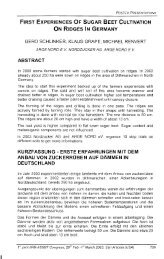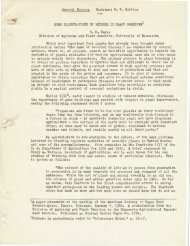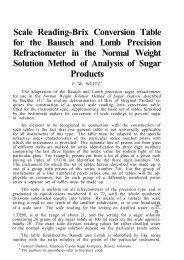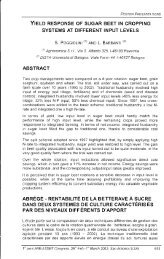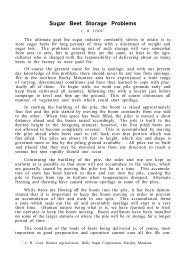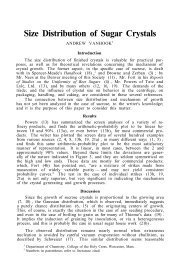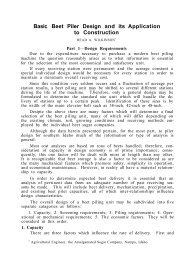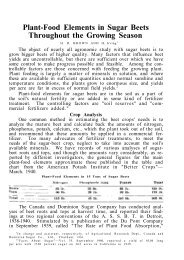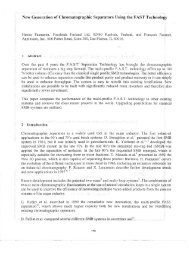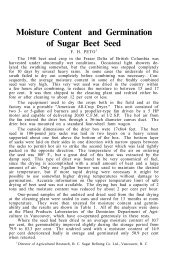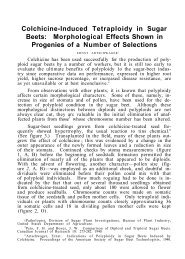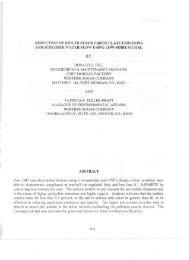membrane filtration of various sugar solutions - ASSBT Proceedings
membrane filtration of various sugar solutions - ASSBT Proceedings
membrane filtration of various sugar solutions - ASSBT Proceedings
You also want an ePaper? Increase the reach of your titles
YUMPU automatically turns print PDFs into web optimized ePapers that Google loves.
An expected purity rise across a <strong>membrane</strong> did not exceed 0.5-0.6. Results look reasonable<br />
because most <strong>of</strong> the non-<strong>sugar</strong>s are present in dissolved form and the size <strong>of</strong> their molecules is too<br />
small to be removed by rvfF or even "loose" UF <strong>membrane</strong>s. Complete juice sterilization and<br />
suspended solids removal was achieved. Both color and dextran levels were reduced significantly in<br />
all tests. Apparently high molecular weight dextrans and color-forming molecules are rejected by MF<br />
<strong>membrane</strong>s. This phenomenon may be explained by formation <strong>of</strong> a dynamic layer on the surface <strong>of</strong><br />
a ceramic <strong>membrane</strong>. Late experiments with MF and UF <strong>membrane</strong>s with pore sizes ranging from<br />
200,000 MWCO to 0.2 micron showed insignificant difference in dextrans and color rejection . This<br />
confirms the theory that dynamic <strong>membrane</strong> is responsible for separation characteristics. Slight total<br />
hardness reduction can be explained by removal <strong>of</strong> precipitated calcium salts <strong>of</strong> organic acids. In<br />
general results appear to be very attractive from a technological standpoint. Micro<strong>filtration</strong> provides<br />
perfect pretreatment prior to ion-exchange s<strong>of</strong>tening and further chromatographic puritlcation.<br />
Cane molasses from <strong>various</strong> sources has been tested in rvfF experiments. Analytical results<br />
are presented in Table 2. Slight apparent purity rise was observed across the <strong>membrane</strong>. Suspended<br />
solids removal was adequate for chromatographic separator feed material. Usually cane molasses<br />
from <strong>various</strong> sources demonstrates significantly different properties, such as hardness, suspended<br />
solids, etc. Cane mixed juice treatment appear to be more technologically attractive solution.<br />
Suspended solids removal will be the only requirement for the <strong>membrane</strong> process. Certain screening<br />
should be required to eliminate bagasillo and large paticulate matter which may plug the <strong>membrane</strong><br />
channels. A chromatographic separator will do an excellent job <strong>of</strong> purification and color removal.<br />
The second set <strong>of</strong> tests was carried out for two months during the 1995-96 beet slicing<br />
campaign. A fully automated <strong>membrane</strong> skid was operated in feed and bleed mode. Feed w as<br />
pretreated using ARi proprietary technology. Pretreated beet raw juice contained about 0.3% vol.<br />
suspended solids and was screened through 250 micron sieve. Several MF <strong>membrane</strong>s have been<br />
tested. Feed juice temperature was maintained at 90 D C to minimize viscosity and prevent bacterial<br />
gro"Wth. Typical test results are shown in Figures 3 and 4. Dow CMF hollow fiber <strong>membrane</strong>s with<br />
3 mm I.D. showed good and stable performance without cleaning for 5 days at 120 GFD . High<br />
temperature epoxy tubesheet formulation was used in all tests. Several fibers were broken during the<br />
tests. Regardless <strong>of</strong> relatively good performance we do not consider hollow fi ber <strong>membrane</strong>s<br />
suitable for <strong>sugar</strong> juice applications due to the possibility <strong>of</strong> unexpected failure and replacement<br />
expenses.<br />
With Ceramem <strong>membrane</strong>s (2x2 mm channels) it was po sible to sustain flux at 100-105 GFD<br />
for over two days with slow TMP increase over the test period. The plot in Figure 5 illustrates that<br />
TMP rise was not a consequence <strong>of</strong><strong>membrane</strong> fouJing. Some beet fibers were breaking through the<br />
screens and slowly accumulating between two modules in series. This phenomenon can be avoided<br />
with modified pretreatment.<br />
Taking into consideration the size <strong>of</strong> potential investment and importance <strong>of</strong> the long-term<br />
testing we tested several <strong>membrane</strong>s during the campaign <strong>of</strong> 1996-97. All tested <strong>membrane</strong>s produce<br />
permeate <strong>of</strong> excellent quality sufficient for further chromatographic separation. Final selection should<br />
be accomplished by comparing capital and operating expenses for different systems. Since the cost<br />
<strong>of</strong> <strong>membrane</strong> replacement may be 30-60% <strong>of</strong> an initial capital investment, evaluation <strong>of</strong> a <strong>membrane</strong><br />
364 <br />
- - --- _._-- - -------



